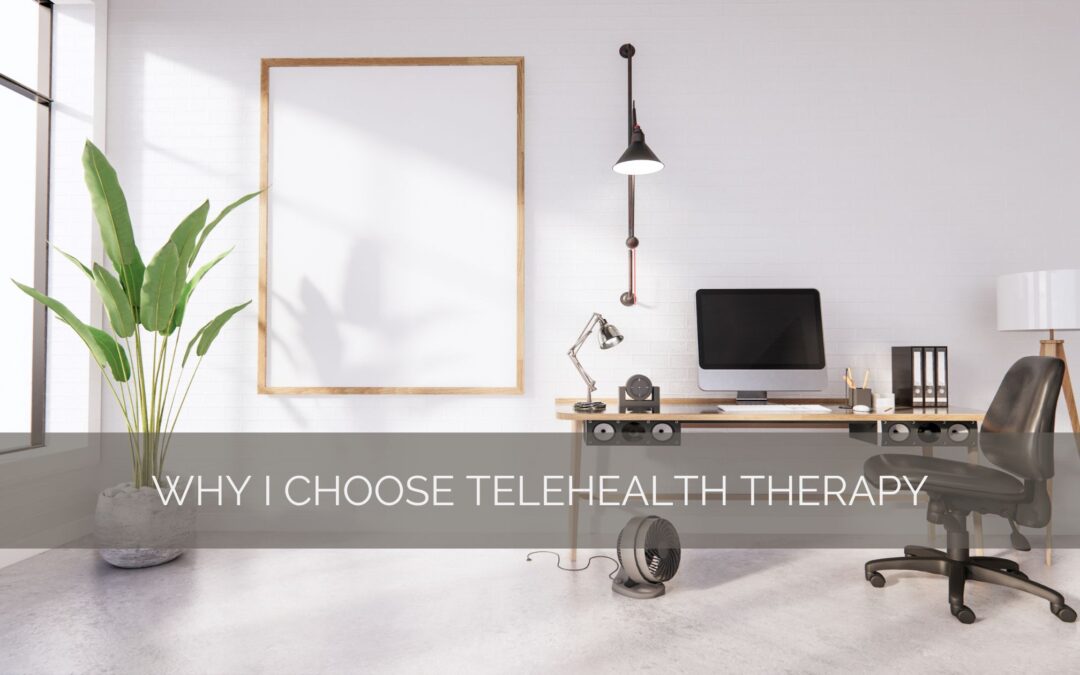Most therapists never imagined practicing telehealth because our work is so relational, and we felt like the screen was a barrier to connecting with our clients. At the beginning of the pandemic, we all had to quickly pivot and transition to telehealth as a way to continue supporting our clients, thinking it would be a stopgap. Three years later, many therapists still prefer in-person sessions and have returned to seeing clients in their offices, but I have continued to offer telehealth services because of the immense value it provides. In addition to the ones listed below, the biggest value is being able to increase access to more people, from those that live busy lives and don’t have time to commute to an office to those that live in rural or mountain towns and have limited access to quality mental health services.

Here is what I have learned from doing this work for the past three years and how you can really benefit from telehealth:
- Instead of me, the therapist, creating the therapeutic space (i.e., decorating their office, positioning their furniture), you get the unique opportunity to create your own space. We can also do this together by talking through – choosing a room, thinking about lighting and temperature of the room, bringing in things that provide comfort – favorite tea, blanket, scent.
- This can be especially helpful if you’re engaging in EMDR and trauma work (a safe space to do intense work).
- Personalized options can also make you feel more relaxed, prompting more openness.
- Physical cues don’t always translate to the screen, but we can use this to our advantage. Some body language and facial expressions are harder to see and read through a screen, and instead of seeing this as a barrier, I see this as an opportunity to help clients notice and share their body sensations and movements with me – this not only helps me know what I may be missing or not picking up on, it also increases your own awareness of body and emotional cues, which will ultimately help you navigate the struggles that come up in your daily life.
- To help you feel comfortable sharing with me the cues that I might miss, I invite and create a space of openness, curiosity, honesty, and transparency. Our time together increases your self-awareness and provides an opportunity for you to practice sharing your thoughts and feelings, speaking up, and advocating for yourself.
- I value the importance of self-care, and I use our telehealth sessions as a starting point. An example of this includes helping you figure out what you might need right before and right after a session instead of just coming from a work meeting and jumping right back into work. You may not know the answer to this initially, but through our work together, it will become more known to you, thus increasing your ability to know how to take care of yourself outside of sessions.
- Transitions are important in therapy. Sometimes, it can be easier to transition into therapy without the commute/traffic/time pressure of being on time and privately transition out of therapy without leaving the office immediately. This is often a flexible and convenient option, saving you time and energy. Some of my clients can even attend therapy without taking time off work or arranging for childcare. For parents and couples, this could mean going to therapy during the day to be present with their families at night.
Another important aspect of privately transitioning out of therapy is that you can do so at your own pace, and you don’t need to worry about who you might bump into afterward. Sometimes it can feel awkward leaving therapy, especially after a harder EMDR session. When you are in the comfort of your own space, you don’t have to worry about running into someone or anyone. You can also take your time to gather your thoughts and perhaps engage in a self-care activity before moving on with your day, all without losing the comfort of the space we have created.
- You may notice that you can access more depth in telehealth from either having more personal space in your own safe space and/or feeling less imposition from your therapist. When you’re not worried about these things, you can get into the therapeutic work with more ease.
Over the past three years, while exclusively providing telehealth services, I have supported my clients as they courageously walked into deep, therapeutic work to heal past wounds, gain clarity of their patterns, and find compassion for themselves. If you’d like to begin this journey with me, click here to learn more about my services.
Meet the author: Dr. Dorothy Moon
Learn More about Dorothy’s approach to therapy
Photo Credits:
Photo by Sincerely Media on Unsplash
Photo by Dillon Shook on Unsplash


 Another important aspect of privately transitioning out of therapy is that you can do so at your own pace, and you don’t need to worry about who you might bump into afterward. Sometimes it can feel awkward leaving therapy, especially after a harder EMDR session. When you are in the comfort of your own space, you don’t have to worry about running into someone or anyone. You can also take your time to gather your thoughts and perhaps engage in a self-care activity before moving on with your day, all without losing the comfort of the space we have created.
Another important aspect of privately transitioning out of therapy is that you can do so at your own pace, and you don’t need to worry about who you might bump into afterward. Sometimes it can feel awkward leaving therapy, especially after a harder EMDR session. When you are in the comfort of your own space, you don’t have to worry about running into someone or anyone. You can also take your time to gather your thoughts and perhaps engage in a self-care activity before moving on with your day, all without losing the comfort of the space we have created.


